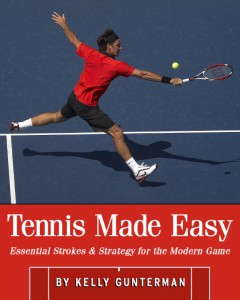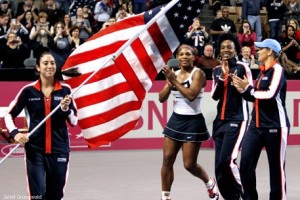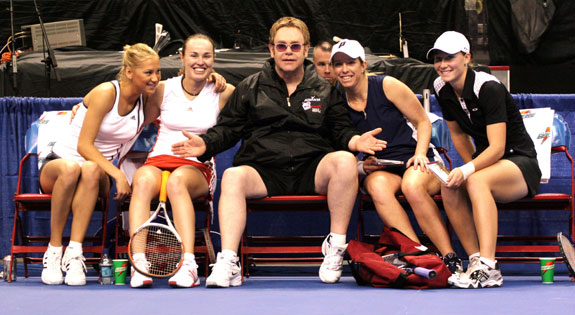You are in between USTA League Tennis matches or tournaments and you need to work on your game. What are some ways to sharpen up your skills? Noted tennis instructor Kelly Gunterman tells you in his book “Tennis Made Easy” ($19.95, New Chapter Press, Available here: http://www.amazon.com/Tennis-
The following is an excerpt from Gunterman’s book that outlines how to practice.
***
 The legendary golf professional Gary Player once said,
The legendary golf professional Gary Player once said,
“The more I practice, the luckier I get”
This quote rings true on the tennis court as well as the golf course.
Another quote we can apply to our tennis game is, “Practice doesn’t make perfect, perfect practice makes perfect.” In other words, when you head out to practice, focus. Try to practice all of your shots in a way that improves your overall game. It is unrealistic to think we can play a perfect game of tennis. There are a lot of variables, including the weather, our opponent and our game. By striving to make practice perfect, you can only improve your chances when you step on the court for a match.
You have made a commitment to improve your tennis with instruction, books and videos, but all of it won’t help if you don’t practice. Establish some goals and discuss them with your coach. Having clear cut goals aids in the learning process and helps avoid frustration. Make your goals, both the long and short term, clear and achievable. Armed with a solid understanding of how to hit all of the various shots, you can now practice your new skills and ultimately incorporate them into your game.
If you are alone, don’t panic. You have plenty of options to practice your tennis. You can improve your strokes and work on conditioning in a couple of ways.
Practicing Alone
A ball machine is the best way to incorporate a new skill into your game or to work out a bad habit. This machine simply throws balls to you so you can practice a specific stroke or shot, with no pressure to hit the ball back to a person or to a specific spot on the court. This frees you up to experiment with the stroke. Avoid setting the machine to throw too fast or too quickly, as it may be frustrating. Take it slow, focusing on the changes you want to incorporate into your game. Some machines oscillate, by throwing the ball from side to side. Don’t let your ego get in the way by trying to run from corner to corner. That may sound a little confusing. Use the ball machine to work on your strokes, try not to be the macho player that has to run after every ball. You can’t beat the machine. Use the ball machine with a friend too, one hits and one picks up, then change places.
When a partner can’t be found, try a backboard. It can also be very frustrating. So focus on being as consistent as possible. If you over hit or hit too hard, most of your time will be spent picking up balls. Be patient and work your strokes and footwork, not your power. This is also a very effective way to work on your volleys. Start about 8-10 feet from the wall and volley as long as you can keep the ball going. Hit only forehand volleys and then only backhand volleys. As you progress, try to alternate between the two. This cuts down the shoulder turn and simplifies the volley on both sides. Be creative and have fun.
Practice with a Partner
When using a progressive warm up, start slowly. Mini-tennis is a favorite of mine. From opposite service lines gently stroke the ball back and forth using both backhands and forehands. The secret to hitting softly is to shorten your swing. The closer you get to the net, the shorter your backswing. After a few minutes of mini-tennis, move back to the middle of the court to “no-man’s land.” Now you will have to hit half-volleys and groundstrokes to keep the rally alive. By lengthening the swing, try to have the ball to bounce on the opposite service line.
Then move to the baseline. Use a full swing but not full speed. Start with only about 75% of your maximum pace. Remember you are still warming up. Keep your feet moving and work on control. Pay special attention to the contact point in the swing. As you start to get a rhythm on your strokes, begin to hit in a direction. First with cross court forehands and then backhands. Keep the ball in play and begin to increase the pace just a little while staying consistent. Don’t forget to hit down the line as well. Try alternating forehand and backhand shots. This increases the number of steps between shots, improving your footwork.
To increase the intensity of the drill, have your partner stay in the forehand half of the court and hit down the line then cross court. You move side to side, directing your shots back to your partner. After a few minutes, switch having your partner move side to side so you both have to run. Make sure you hit balls to both sides of he court. To really get your heart going, hit down the line and have your partner hit cross court so both of you move side to side. Make sure you switch directions, ensuring you both practice hitting all of the shots. Have a great workout! Don’t over hit. These are consistency drills.
These patterns are also great with one player at the net and one at the baseline. Keep working on directional control and depth.
Practice with Three Players
While waiting for a fourth to show for doubles, there are a myriad of drills to explore. The old stand by two–on–one drill has a lot of variations. Here are a few.
1. Two–on–one from the baseline. All players are back with a doubles team on one baseline and the singles player on the other. The doubles players hit down the line while the singles player hits cross court. A good workout for the singles player is maintaining steadiness to keep the rally going. For increased intensity, have the doubles players hit cross court and the singles player hit down the line. Keep rotating around so no one is left out of the running. This very simple drill is super for working on changing the direction of the ball. Vary the drill by keeping the singles player on one side. The doubles players only hit to that side. Play this as a groundstroke game but attack any short ball and go to net. Both teams work the transition from the baseline to the net with their split step. Keep score as it keeps everyone focused. Try playing games to ten, play both sides and rotate around.
2. Two at the net, one on the baseline. Have the two volleyers hit for the singles court and the baseline player hit to the doubles court. Play this drill for control or play out points. Keeping score is a great way to stay motivated. Either way this is a fun drill that works your entire game.
3. Two at the baseline one at the net. This is a variation of the previous drill. Throw in some lobs for variety or limit lobbing to build consistency on the groundstrokes.
Practice with Four Players
When most players head on the court, they warm up for five or ten minutes and are ready to take some serves. Instead, extend the warm up making it a practice session.
1. Hit in all of the directions, cross court forehands and backhands from the baseline and with two players at the net. Hit some lobs and overheads. Literally hit all the shots. Spend five to ten minutes hitting in each direction, don’t forget down the line groundstrokes and volleys.
2. Have some fun playing volley points. Two players start on each service line hitting volleys and playing out the point. Close in after each shot and play this without letting the ball bounce. It’s very fast and a lot of fun. Keep score to make everyone focus a bit more. Try games to seven or ten points.
3. Move two players back to the baseline and play some points with two up and two back. Eliminate the bounce for the net team and allow anything goes for the baseline team. This is a great drill to sharpen the skills needed in doubles.
4. Start with all four players back and rally until one team gets a short ball to attack and finish the point at net. This is great for working the depth of your groundstrokes and understanding when to attack the short ball.
5. Be creative. Make up your own drills to work on your weak shots. If you are a doubles player, try to work most of the drill cross court and come in to the net. There are endless possibilities when it comes to ways to practice. Most of all, have fun.
Getting in Shape for Tennis
Tennis is a great way to develop your overall fitness. Implementing an off-court training program can help lift the level of your game. If you are more fit and don’t change anything in your game, you will play better and for a longer period of time. As with any fitness program, consult your physician before beginning a new program.
To get the most bang for your workout buck, consult with a certified personal trainer. They can develop a program that is sport specific and geared to improving your tennis game.
Tennis is a unique sport that is primarily an anaerobic activity. The short bursts of activity require quicker movements for shorter periods of time. Increasing your aerobic fitness will greatly reduce your recovery time between points. It also improves your endurance for those long, three-set matches. Overall fitness is the goal with the target of improving your tennis game. Let’s look at all of the options from quickness and strength training to aerobic fitness and stretching.
Strength Training doesn’t necessarily mean throwing around heavy weights. A better option may be lighter weights with more repetitions being the goal. We want to build strength and endurance, not bulk. Iso-metric resistance bands, the thick rubber band device you may have seen in the gym, are bands that stretch and will add resistance to a given exercise. Stretch the resistance band and hold it for a given period of time and then release. This sounds simple but it is very effective. Also, good old fashioned push-ups are a fantastic way to increase your strength. Your personal trainer can show you many variations for the push up, depending on your strength.
Quickness Drills are designed to improve quickness and first-step speed. In tennis, you never need to run a mile, but how quick you make the first step or two is ultimately important. A jump rope will also help to increase foot speed. It’s not only for little kids. It’s fun and will help your footwork.
Cardio Training is designed to keep your heart rate in its target zone for a minimum of 20 minutes. Cardiovascular exercise increases the oxygen in the blood stream and aids in recovery between long points. Some examples of cardiovascular exercises are biking, elliptical trainers, stair-climbing machines and jogging. It is a good idea to use a heart rate monitor as this will help ensure your heart rate is in the target zone for the optimum training benefit. Avoid a lot of bone jarring activities that may cause joint pain. Tennis is jarring enough so save your knees as much as possible.
Core Strength is the strength of the muscles in your core area, abdominals, lower back and oblique muscles. These muscle groups are all tied together and incorporated in almost all tennis shots. Increased strength through crunches, planking and medicine-ball training increases your strength and stamina in this important area of the body.
Stretching and staying flexible is important for all ages but even more important as we start to age. Improved flexibility helps avoid injury and increases rotational speed in almost all of our tennis strokes.
Find the right fitness program for your needs and make the available time to work out. A trained fitness professional can help explain all of these ideas. The value of a good fitness and strength program is proven when you easily hit the court and take a set from a worthy opponent. There are a lot of good tennis specific books on training available. If you don’t have access to a personal trainer, look for one of these books.


